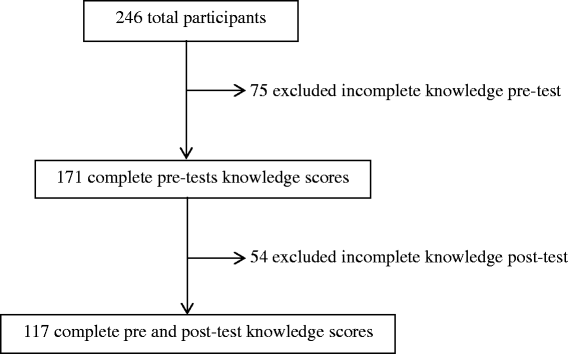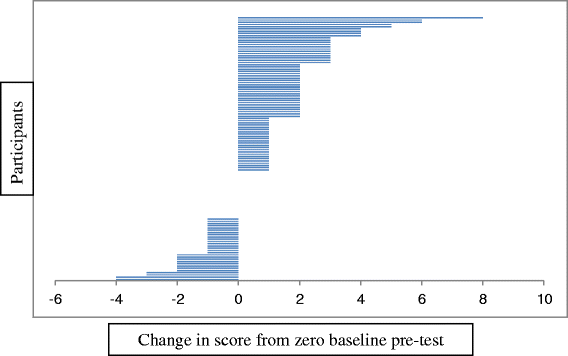Improving rural and remote practitioners' knowledge of the diabetic foot: findings from an educational intervention
- PMID: 27478506
- PMCID: PMC4966728
- DOI: 10.1186/s13047-016-0157-2
Improving rural and remote practitioners' knowledge of the diabetic foot: findings from an educational intervention
Abstract
Background: This study aimed to determine knowledge of national guidelines for diabetic foot assessment and risk stratification by rural and remote healthcare professionals in Western Australia and their implementation in practice. Assessment of diabetic foot knowledge, availability of equipment and delivery of foot care education in a primary healthcare setting at baseline enabled evaluation of the effectiveness of a diabetic foot education and training program for generalist healthcare professionals.
Methods: This study employed a quasi-experimental pre-test/post-test study design. Healthcare practitioners' knowledge, attitudes and practice of diabetic foot assessment, diabetic foot risks, risk stratification, and use of the 2011 National Health and Medical Research Council Guidelines were investigated with an electronic pre-test survey(.) Healthcare professionals then undertook a 3-h education and training workshop before completing the electronic post-test knowledge, attitudes and practice survey. Comparison of pre-test/post-test survey findings was used to assess the change in knowledge, attitudes and intended practice due to the workshops.
Results: Two hundred and forty-six healthcare professionals from two rural and remote health regions of Western Australia participated in training workshops. Monofilaments and diabetes foot care education brochures, particularly brochures for Aboriginal people, were reported as not readily available in rural and remote health services. For most participants (58 %), their post-test knowledge score increased significantly from the pre-test score. Use of the Guidelines in clinical settings was low (19 %). The healthcare professionals' baseline diabetic foot knowledge was adequate to correctly identify the high risk category. However, stratification of the intermediate risk category was poor, even after training.
Conclusion: This study reports the first assessment of Western Australia's rural and remote health professionals' knowledge, attitudes and practices regarding the diabetic foot. It shows that without training, generalists' levels of knowledge concerning the diabetic foot was low and they were unlikely to assess foot risk. The findings from this study in a rural and remote setting cast doubt on the ability of generalist healthcare professionals to stratify risk appropriately, especially for those at intermediate risk, without clinical decision support tools.
Keywords: Attitude; Diabetic foot; Knowledge; Practice; Risk stratification.
Figures
Similar articles
-
The effectiveness of internet-based e-learning on clinician behavior and patient outcomes: a systematic review protocol.JBI Database System Rev Implement Rep. 2015 Jan;13(1):52-64. doi: 10.11124/jbisrir-2015-1919. JBI Database System Rev Implement Rep. 2015. PMID: 26447007
-
Beyond the black stump: rapid reviews of health research issues affecting regional, rural and remote Australia.Med J Aust. 2020 Dec;213 Suppl 11:S3-S32.e1. doi: 10.5694/mja2.50881. Med J Aust. 2020. PMID: 33314144
-
Evaluation of the impact of an educational initiative in diabetic foot management.Br J Community Nurs. 2004 Mar;9(3):S20-6. doi: 10.12968/bjcn.2004.9.Sup1.12504. Br J Community Nurs. 2004. PMID: 15029004 Clinical Trial.
-
The Fly-in Fly-out and Drive-in Drive-out model of health care service provision for rural and remote Australia: benefits and disadvantages.Rural Remote Health. 2015 Jul-Sep;15(3):3068. Epub 2015 Jul 19. Rural Remote Health. 2015. PMID: 26190237 Review.
-
How does trauma informed care education for paediatric healthcare professionals' impact self-reported knowledge and practice. An integrative review.Nurse Educ Pract. 2025 Jan;82:104227. doi: 10.1016/j.nepr.2024.104227. Epub 2024 Dec 9. Nurse Educ Pract. 2025. PMID: 39671749 Review.
Cited by
-
Is ethnicity an appropriate measure of health care marginalization? A systematic review and meta-analysis of the outcomes of diabetic foot ulceration in Aboriginal populations.Can J Surg. 2021 Oct;64(5):E476-E483. doi: 10.1503/cjs.004619. Can J Surg. 2021. PMID: 34580076 Free PMC article.
-
Demonstrating Impact: Lessons Learned from the Queensland Aboriginal and Islander Health Council's AOD-Our-Way Program.Int J Environ Res Public Health. 2018 Mar 5;15(3):450. doi: 10.3390/ijerph15030450. Int J Environ Res Public Health. 2018. PMID: 29510586 Free PMC article.
-
Knowledge, attitudes and practices on diabetic foot care among nurses in Kimberley, South Africa.S Afr Fam Pract (2004). 2024 Jun 25;66(1):e1-e10. doi: 10.4102/safp.v66i1.5935. S Afr Fam Pract (2004). 2024. PMID: 38949451 Free PMC article.
-
Work ability and productivity in patients with diabetic foot.Clinics (Sao Paulo). 2019 Mar 25;74:e421. doi: 10.6061/clinics/2019/e421. Clinics (Sao Paulo). 2019. PMID: 30916210 Free PMC article.
-
Knowledge, Attitude and Practice on Diabetic Wound Care Management among Healthcare Professionals and Impact from A Short Course Training in Sabah, Borneo.Medeni Med J. 2020;35(3):188-194. doi: 10.5222/MMJ.2020.02929. Epub 2020 Sep 30. Medeni Med J. 2020. PMID: 33110670 Free PMC article.
References
-
- UK Prospective Diabetes Study (UKPDS) Group Intensive blood-glucose control with sulphonylureas or insulin compared with conventional treatment and risk of complications in patients with type 2 diabetes (UKPDS 33) Lancet. 1998;3529131:837–853. - PubMed
-
- Baxter M, Hudson R, Mahon J, Bartlett C, Samyshkin Y, Alexiou D, et al. Estimating the impact of better management of glycaemic control in adults with Type 1 and Type 2 diabetes on the number of clinical complications, and the associated financial benefit. Diabet Med. 2016 - PubMed
-
- National Health and Medical Research Council. National evidence-based guideline: prevention, identification and management of foot complications in diabetes. (Part of the Guidelines on the management of Type 2 Diabetes). National Health and Medical Research Council, Melbourne. 2011. http://t2dgr.bakeridi.edu.au/LinkClick.aspx?fileticket=anrL23t3ADw%3d&ta.... Accessed 10 Apr 2011
-
- Crawford F, Cezard G, Chappell FM, Murray GD, Price JF, Sheikh A, et al. A systematic review and individual patient data meta-analysis of prognostic factors for foot ulceration in people with diabetes: the international research collaboration for the prediction of diabetic foot ulcerations (PODUS) Health Technol Assess. 2015;1957:1–210. doi: 10.3310/hta19570. - DOI - PMC - PubMed
Publication types
MeSH terms
LinkOut - more resources
Full Text Sources
Other Literature Sources
Medical
Miscellaneous



